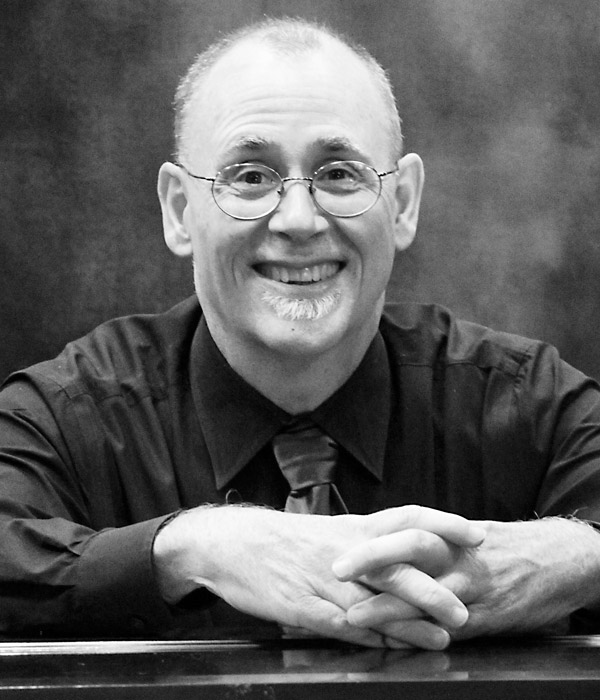You are here
February 2024 Concert
This lovely concert features three of the Soviet Era’s greatest composers. We open with four dances from Aram Khachaturian’s ballet Gayane, including the justly famous Sabre Dance. Dmitri Shostakovich wrote his Piano Concerto No. 2, a jubilant romp, for his 19-year-old son and piano student, Maxim. Rick Ferguson is our featured soloist.
Sergei Rachmaninoff’s last major composition, Symphonic Dances, closes our concert. He wrote this profound, beautiful, energetic, and sensuous masterpiece in America.
Program
Musical Insights Free Pre-Concert Preview the Friday before this concert.
Learn How to Attend!
- Khachaturian
- Four Dances from Gayane
- Shostakovich
- Piano Concerto No. 2 in F Major
Rick Ferguson, piano
- Rachmaninoff
- Symphonic Dances
Pick-Staiger Concert Hall
50 Arts Circle Drive, Evanston
See map.
TICKETS
Buy TicketsAll tickets are assigned seating.
At this time, masks, vaccinations and testing are no longer required to attend ESO concerts or events. As always, we ask that if you are sick, please stay home to prevent the spread of illness. (read more detail).
Advance Sales
$35 Adult, $30 Seniors, $5.00 Full-Time Student
At the Door Sales
$39 Adult, $35 Seniors, $5.00 Full-Time Student
Children Free
Children 12 and younger are admitted absolutely FREE, but must have an assigned seat.
Please call 847.864.8804 or email tickets@evanstonsymphony.org for all orders with children’s tickets.
Soloist
Rick Ferguson, piano

Program Notes
Four Dances from Gayane
Aram Khachaturian (1903–1978) 15 minutes (1942)
ARMENIA’S NATIONAL BALLET. Aram Khachaturian is generally regarded as the greatest composer in the history of Armenia. This despite the fact that he was born in Tiflis (now Tbilisi) Georgia, he never lived in Armenia, he spoke Russian as his first language, and he moved to Moscow when he was 18 years old. But his parents were Armenian and his music reflects the national characteristics of Armenian music as well as that of other regional musics. Khachaturian first gained fame with his Piano Concerto (1936) and Violin Concerto (1940), which was premiered by David Oistrakh. But he is principally renowned for his ballets: Gayane (1942) and Spartacus (1956). The four dances played on today’s program are drawn from two of the three suites which Khachaturian assembled in 1943, and they reflect the official Soviet policy at the time of encouraging diverse folk cultures. Thus the “Hopak” is a Ukrainian dance while the “Sabre Dance,” Khachaturian’s “greatest hit,” is more typical of Armenian folk music.
— Program note by David Ellis.
Piano Concerto No. 2 in F Major
Dmitri Shostakovich (1906–1975) 20 minutes (1957)
The year 1957 was a busy time for Soviet-Russian composer Dmitri Shostakovich. During the first six months of the year he not only put the finishing touches on his Second Piano Concerto, but also attended the Second All-Union Congress of Composers for which he published a number of articles on topics related to the development of Soviet music. In addition, Shostakovich was also hard at work on his Symphony No. 11, written to mark the 40th anniversary of the October Revolution.
However, the highlight of this year for Shostakovich may well have been the graduation of his son, Maxim, from the Moscow Conservatory of Music. In honor of Maxim’s graduation, Shostakovich wrote a piano concerto which Maxim premiered on May 10, 1957 with the USSR State Symphony Orchestra and conductor Nikolai Anosov.
This compact work is in a classical three-movement structure and offers the transparency of Mozart, the power and drive of Beethoven, and Shostakovich’s own mixture of lyricism, wit and emotional range. It is scored for piccolo, two flutes, two oboes, two Bb clarinets, two bassoons, four horns in F, timpani, side drum and strings.
The opening movement juxtaposes two equally lyrical melodies (F Major/D Minor) with the primary theme being a constant presence which is taken through its paces in all manner of exchanges between piano and orchestra. The middle movement gives us a love letter to Maxim, with the piano and orchestra creating a poignantly beautiful interlude whose harmonic backdrop recalls old-style Russian church music. As the second movement gradually fades into the mist, we suddenly find ourselves in the midst of Shostakovich recalling his love of circus music and lively, irregular rhythms. Shostakovich brilliantly incorporates Hanon finger exercises into this texture, no doubt as an homage to all of Maxim’s (and his own!) years of training at the instrument.
— Program note by Rick Ferguson.
Symphonic Dances, Op. 45
Sergei Rachmaninoff (1873–1943) 35 minutes (1940)
After finishing his Third Symphony in 1936, Rachmaninov quit composing, discouraged by the lukewarm reception several of his recent scores had met. With the outbreak of war in 1939, Rachmaninov and his wife Natalya left Europe for the last time and settled in Orchard Point, an estate he had rented on Long Island. Throughout the summer of 1940, Rachmaninov was busy preparing for his upcoming concert tour—he regularly practiced every day from early morning until eleven at night—and, for the first time in years, he found that he couldn’t resist the urge to compose. On August 21, he wrote to Eugene Ormandy, who had conducted some of Rachmaninov’s greatest successes with the Philadelphia Orchestra, “Last week I finished a new symphonic piece, which I naturally want to give first to you and your orchestra. It is called Fantastic Dances. I shall now begin the orchestration.”
The Philadelphia premiere was well received, but a subsequent performance in New York was panned. Rachmaninov was hurt that Ormandy didn’t appear interested in recording the new work. The Symphonic Dances turned out to be his last score, and Rachmaninov died believing that it would never find the kind of popularity his earlier music had so easily won. But in recent years, the score has become a favorite of orchestras and audiences alike—Rachmaninov’s star is once again on the rise.
The first dance has an extended solo for saxophone, an instrument for which Rachmaninov had never before written. The second movement is a melancholy waltz (in 6/8 time) that only turns more anxious and wistful as it progresses. The finale quotes the chant of the Russian Orthodox liturgy as well as the Gregorian melody of the Dies irae from the Mass for the Dead. It also recycles part of his All-Night Vigil, an a cappella choral work dating from 1915, but this is no secret quotation, for Rachmaninov writes the original text, “Alliluya,” in the score at that point. Perhaps guessing that this would be his final work—“It must have been my last spark,” he said at the time—Rachmaninov wrote at the end of his manuscript, “I thank thee, Lord.”
— Program note by Phillip Huscher, program annotator for the Chicago Symphony Orchestra.
Reprinted with permission © Chicago Symphony Orchestra Association

